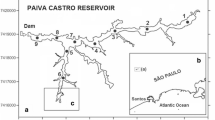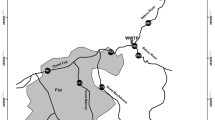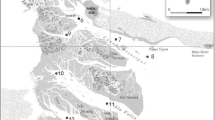Abstract
To assess the long-term anthropogenic load of the Bílina River (Czech Republic), the concentrations of heavy metals and specific organic compounds in different river ecosystem matrices (water, biofilms, and sediments) were determined. Although the current concentrations of pollutants in surface water are low, frequently below the limits of the quantitative analytical methods used, the river ecosystem is still heavily loaded by anthropogenic pollution, mainly from the chemical and mining industries. This was demonstrated by analyzing biofilms and sediments. These matrices are more accurate representatives of the actual situation in the river and do not depend on hydrological conditions or random variability in water quality. The results indicate that the middle and the lower parts of the river are heavily polluted by mercury, arsenic, vanadium, polychlorinated biphenyls, hexachlorobenzene, and dichloro-diphenyl-trichloroethane. As a tributary of the Elbe River, the Bílina River represents a significant risk for the development of quality in this major European river.
Similar content being viewed by others
References
Adams, M. S., Ballin, U., Gaumert, T., Hale, B. W., Kausch, H., & Kruse, R. (2001). Monitoring selected indicators of ecological change in the Elbe River since the fall of the Iron Curtain. Environmental Conservation, 28(4), 333–344. doi:10.1017/S0376892901000364.
Baborowski, M., von Tümpling, W., & Friese, K. (2004). Behaviour of suspended particulate matter (SPM) and selected trace metals during the 2002 summer flood in the River Elbe (Germany) at Magdeburg monitoring station. Hydrology and Earth System Sciences, 8(2), 135–150.
Barth, J. A. C., Steidle, D., Kuntz, D., Gocht, T., Mouvet, C., von Tümpling, W., et al. (2007). Deposition, persistence and turnover of pollutants: First results from the EU project Aqua terra for selected river basins and aquifers. The Science of the Total Environment, 376(1–3), 40–50. doi:10.1016/j.scitotenv.2007.01.065.
Baudo, R., Giesy, J., & Muntau, H. (1990). Sediments: Chemistry and toxicity of in-place pollutants. London: CRC Press.
Behra, R., Landwehrjohann, R., Vogel, K., Wagner, B., & Sigg, L. (2002). Copper and zinc content of periphyton from two rivers as a function of dissolved metal concentration. Aquatic Sciences-Research Across Boundaries, 64, 300–306.
Bergemann, M., & Gaumert, T. (2006). Gewässergütebericht der Elbe. Hamburg: Arbetsgemeinschaft für die Reinhaltung der Elbe.
Borovec, Z., Pivnièka, K., & Fuksa, J. K. (1998). Mercury in sediments and fish in Czech rivers: A review. Acta Universitatis Carolinae Environmentalica, 12, 7–40.
Brügmann, L. (1995). Metals in sediments and suspended matter of the river Elbe. The Science of the Total Environment, 159, 53–65. doi:10.1016/0048-9697(94)04252-I.
BUA (1994). 119 BUA Report: Hexachlorobenzene. CAS-No.118-74-1. BUA (Advisory Committee on Existing Chemicals of Environmental Relevance; Stuttgart: S. Hirzel Wissenschaftliche Verlagsgesellschaft). In Petrlik, J. (2006). The Spolchemie chlor-alkali and chlorine based chemical production plant in Usti nad Labem (Czech Republic)—A case study for unintentional production of hexachlorobenzene. http://www.ipen.org.
Characklis, W. G., & Marshall, K. C. (1990). Biofilms. New York: Wiley.
Commission of European Community (CEC) (2000). Directive 2000/60/EC of the European (2000). Parliament and of the Council of 23 October 2000 establishing a framework for the community action in the field of water policy. Official Journal of the European Union, L327, 1–72.
Costerton, J. W., Lewadowski, Z., De Beer, D., Caldwell, D., Korber, D., & James, G. (1994). Biofilms, the customized microniche. Journal of Bacteriology, 176, 2137–2142.
Courtney, K. D. (1979). Hexachlorobenzene (HCB): A review. Environmental Research, 20(2), 225–266. doi:10.1016/0013-9351(79)90001-X.
ČSN EN ISO/IEC 17 025 (01 5253). Všeobecné požadavky na způsobilost zkušebních laboratoří. (General standard for assessment of professional capability of laboratories).
Demirezen, D., & Aksoy, A. (2004). Accumulation of heavy metals in Typha angustofolia (L.) and Potamogeton pectinatus (L.) Libiny in Sultan Marsh (Kayseri, Turkey). Chemosphere, 56(7), 685–696. doi:10.1016/j.chemosphere.2004.04.011.
Denkhaus, E., Meisen, S., Telgheder, U., & Wingender, J. (2007). Chemical and physical methods for characterization of biofilms. Mikrochimica Acta, 158(1–2), 1–27. doi:10.1007/s00604-006-0688-5.
Donlan, R. M. (2002). Biofilms: Microbial life on surfaces. Emerging Infectious Diseases, 8(9), 881–890.
Durrieu, G., Maury-Brachet, R., Girardin, M., Rochard, E., & Boudou, A. (2005). Contamination by heavy metals (Cd, Zn, Cu and Hg) of eight fish species in the Gironde Estuary (France). Estuaries, 28(4), 581–591. doi:10.1007/BF02696069.
Farag, A. M., Woodward, D. F., Goldstein, J. N., Brumbaugh, W. G., & Meyer, J. S. (1998). Concentrations of metals associated with mining waste in sediments, biofilm, benthic invertebrates, and fish from the Coeur d’Alene River Basin, Idaho. Archives of Environmental Contamination and Toxicology, 34, 119–127. doi:10.1007/s002449900295.
Farag, A. M., Nimick, D. A., Kimball, B. A., Church, S. E., Harper, D. D., & Brumbaugh, W. G. (2007). Concentrations of metals in water, sediment, biofilm, benthic macroinvertebrates, and fish in the boulder river watershed, Montana, and the role of colloids in metal uptake. Archives of Environmental Contamination and Toxicology, 52, 397–409. doi:10.1007/s00244-005-0021-z.
Flemming, H.-C. (1993). Biofilms and environmental protection. Water Science and Technology, 27(7–8), 1–10.
Flemming, H.-C. (1995). Sorption sites in biofilms. Water Science and Technology, 32(8), 27–33. doi:10.1016/0273-1223(96)00004-2.
Franke, S., Heinzel, N., Specht, M., & Francke, W. (2005). Identification of organic pollutants in waters and sediments from the Lower Mulde River area. Acta Hydrochimica et Hydrobiologica, 33(5), 519–542. doi:10.1002/aheh.200400588.
Frost, P. C., & Elser, J. J. (2002). Growth responses of littoral mayflies to the phosphorus content of their food. Ecology Letters, 5, 232–240. doi:10.1046/j.1461-0248.2002.00307.x.
Fuchs, S., Haritopoulou, T., & Wilhelmi, M. (1996). Biofilms in freshwater ecosystems and their use as a pollutant monitor. Water Science and Technology, 34(7–8), 137–140. doi:10.1016/S0273-1223(96)00735-4.
Gewurtz, S. B., Lazar, R., & Haffner, G. D. (2000). Comparison of polycyclic aromatic hydrocarbon and polychlorinated biphenyl dynamics in benthic invertebrates of lake Eire, USA. Environmental Toxicology and Chemistry, 19, 2943–2950. doi:10.1897/1551-5028(2000)019<2943:COPAHA>2.0.CO;2.
Gold, C., Feurtet-Mazel, A., Coste, M., & Boudou, A. (2003). Effects of cadmium stress on periphytic diatom communities in indoor artificial streams. Freshwater Biology, 48, 316–328. doi:10.1046/j.1365-2427.2003.00980.x.
Greger, M., & Kautsky, L. (1991). Effects of Cu, Pb and Zn on two Potamogeton species grown under field conditions. Plant Ecology, 97(2), 173–184. doi:10.1007/BF00035390.
Havlík, A., Just, T., & Slavík, O. (1997a). Ekologická studie povodí Bíliny. 1. díl. Podrobná ekologická studie (Ecological study of the Bílina River. Part 1. Detailed ecological study). Prague: T.G. Masaryk Water Research Institution, PRI. (in Czech).
Havlík, A., Just, T., & Slavík, O. (1997b). Ekologická studie povodí Bíliny. 2. díl. Kvalita vody a produkce zneèištìní v povodí Bíliny (Ecological study of the Bílina River. Part 2. Water quality and pollution production in the bílina River drainage area). Prague: T.G. Masaryk Water Research Institution, PRI.
Heemken, O. P., Reincke, H., Stachel, B., & Theobald, N. (2001). The occurrence of xenoestrogens in the Elbe River and the North Sea. Chemosphere, 45, 245–259. doi:10.1016/S0045-6535(00)00570-1.
Heininger, P., Pelzer, J., Claus, E., & Pfitzner, S. (2003). Results of long-term sediment quality studies on the River Elbe. Acta Hydrochimica et Hydrobiologica, 31(4–5), 356–367. doi:10.1002/aheh.200300493.
Heinisch, E., Kettrup, A., Bergheim, W., Martens, D., & Wenzel, S. (2005a). Persistent chlorinated hydrocarbons (PCHC), source-oriented monitoring in aquatic media. 2. The insecticide DDT, constituents, metabolites. Fresenius Environmental Bulletin, 14(2), 69–85.
Heinisch, E., Kettrup, A., Bergheim, W., Martens, D., & Wenzel, S. (2005b). Persistent chlorinated hydrocarbons (PCHC), source-oriented monitoring in aquatic media. 3. The isomers of Hexachlorocyclohexane. Fresenius Environmental Bulletin, 14(6), 444–462.
Hintelmann, H., & Wilken, R.-D. (1995). Levels of total mercury and methyl mercury compounds in sediments of the polluted Elbe River: Influence of seasonally and spatially varying environmental factors. The Science of the Total Environment, 166, 1–10. doi:10.1016/0048-9697(95)04506-V.
Holding, K. L., Gill, R. A., & Carter, J. (2003). The relationship between epilithic periphyton (Biofilm) bound metals and metals bound to sediments in freshwater systems. Environmental Geochemistry and Health, 25, 87–93. doi:10.1023/A:1021205101133.
Ivorra, N., Hettelaar, J., Tubbing, G. M. J., Kraak, M. H. S., Sabater, S., & Admiraal, W. (1999). Translocation of microbenthic assemblages used for in situ analysis of metal pollution in rivers. Archives of Environmental Contamination and Toxicology, 37, 19–28. doi:10.1007/s002449900485.
Jeppesen, E., Sondergaard, M., Christoffersen, K., Theil-Neilsen, J., & Jürgens, K. (2002). Cascading trophic interactions in the litterol zone: An enclosure experiment in shallow Lake Stigsholm, Denmark. Archiv fuer Hydrobiologie, 153, 533–555.
Klemm, W., Greif, A., Broekaert, J. A. C., Siemens, V., Junge, F. W., van der Veen, A., et al. (2005). A study on arsenic and the heavy metals in the Mulde river system. Acta Hydrochimica et Hydrobiologica, 33(5), 475–491. doi:10.1002/aheh.200400592.
Kowalik, C., Kraft, J., & Einax, J. W. (2003). The situation of the German Elbe tributaries—Development of the loads in the last 10 years. Acta Hydrochimica et Hydrobiologica, 31(4–5), 334–345. doi:10.1002/aheh.200300507.
Kröpfl, K., Vladár, P., Szabó, K., Ács, E., Borsodi, A. K., Szikora, S., et al. (2006). Chemical and biological characterisation of biofilms formed on different substrata in Tisza river (Hungary). Environmental Pollution, 144, 626–631. doi:10.1016/j.envpol.2006.01.031.
Landrum, P. F., & Robbins, J. A. (1990). Bioavailability of sediment-associated contaminants to benthic invertebrates. In R. Baudo, J. Giesy & H. Muntau (Eds.), Sediments: Chemistry and toxicity of in-place pollutants (pp. 237–257). London: CRC Press.
Lewandowski, Z., Stoodley, P., Altobelli, S., & Fukushima, E. (1994). Hydrodynamics and kinetics in biofilm systems—Recent advances and new problems. Water Science and Technology, 29(10–11), 223–229.
Liu, M., Cheng, S., Ou, D., Yang, Y., Liu, H., Hou, L., et al. (2008). Organochlorine pesticides in surface sediments and suspended particulate matters from the Yangtze estuary, China. Environmental Pollution, 156, 168–173. doi:10.1016/j.envpol.2007.12.015.
Lotufo, G. R. (1998). Bioaccumulation of sediment-associated fluoranthene in benthic copepods: Uptake, elimination and biotransformation. Aquatic Toxicology (Amsterdam, the Netherlands), 44, 1–15. doi:10.1016/S0166-445X(98)00072-1.
Mages, M., Óvári, M., Tümpling, W., & Kröpfl, K. (2004). Biofilms as bio-indicator for polluted waters? Total reflection X-ray fluorescence analysis of biofilms of the Tisza river (Hungary). Analytical and Bioanalytical Chemistry, 378, 1095–1101. doi:10.1007/s00216-003-2291-5.
McCormick, P. V., & Cairns, J. (1994). Algae as indicators of environmental change. Journal of Applied Phycology, 6, 509–526. doi:10.1007/BF02182405.
Neu, T. R., & Marshall, K. C. (1990). Bacterial polymers physicochemical aspects of their interactions at interfaces. Journal of Biomaterials Applications, 5(2), 107–133. doi:10.1177/088532829000500203.
Oliver, B. G., & Pugsley, C. W. (1986). Chlorinated contaminants in St. Clair River sediments. Water pollution research journal of Canada, 21, 368–379. (In Petrlik, J. (2006). The Spolchemie chlor-alkali and chlorine based chemical production plant in Usti nad Labem (Czech Republic)—A case study for unintentional production of hexachlorobenzene. http://www.ipen.org).
Peng, K., Luo, C., Lou, L., Li, X., & Shen, Z. (2008). Bioaccumulation of heavy metals by the aquatic plants Potamogeton pectinatus L. and Potamogeton malaianus Miq. and their potential use for contamination indicators and in wastewater treatment. The Science of the Total Environment, 392(1), 22–29. doi:10.1016/j.scitotenv.2007.11.032.
Petrlik, J. (2006). The Spolchemie chlor-alkali and chlorine based chemical production plant in Usti nad Labem (Czech Republic)—A case study for unintentional production of hexachlorobenzene. http://www.ipen.org.
Pusch, M., Fiebig, D., Brettar, I., Eisenmann, H., Ellis, B. K., Kaplan, L. A., et al. (1998). The role of micro-organisms in the ecological connectivity of running waters. Freshwater Biology, 40, 453–495. doi:10.1046/j.1365-2427.1998.00372.x.
Schindler, J., Lochovský, P., Tolma, V., Kužílek, V., & Vilimec, J. (1997). Erfassung und Beurteilung der Belastung der Elbe mit Schadstoffen. (In Teilprojekt: Tschechische Elbenebenflüsse (pp. 231–238). Prague: T.G. Masaryk Water Research Institution, PRI.
Schorer, M., & Eisele, M. (1997). Accumulation of inorganic and organic pollutants by biofilms in the aquatic environment. Water, Air, and Soil Pollution, 99, 651–659.
Simon, M. (1991). Die Belastung der Elbe und ihrer Hauptnebenflüsse auf dem Gebiet der ehemaligen DDR. Wasserwirtschaft-Wassertech, 41, 23–27.
Stachel, B., Ehrhorn, U., Heemken, O. P., Lepom, P., Reincke, H., Sawal, G., et al. (2003). Xenoestrogens in the River Elbe and its tributaries. Environmental Pollution, 124(3), 497–507. doi:10.1016/S0269-7491(02)00483-9.
Stachel, R., Götz, R., Herrmann, T., Krüger, F., Knoth, W., Päpke, O., et al. (2004). The Elbe flood in August 2002—Occurrence of polychlorinated dibenzo-p-dioxins, polychlorinated dibenzofurans (PCDD/F) and dioxin-like PCB in suspended particulate matter (SPM), sediment and fish. Water Science and Technology, 50(5), 309–316.
Stachel, B., Jantzen, E., Knoth, W., Krüger, F., Lepom, P., Oetken, M., et al. (2005). The Elbe flood in August 2002—Organic contaminants in sediment samples taken after the flood event. Journal of Environmental Science and Health. Part A, Toxic/Hazardous Substances & Environmental Engineering, 40(2), 265–287. doi:10.1081/ESE-200045531.
Umlauf, G., Bidoglio, G., Christoph, E. H., Kampheus, J., Krüger, F., Landmann, D., et al. (2005). The situation of PCDD/Fs and dioxin-like PCBs after the flooding of River Elbe and Mulde in 2002. Acta Hydrochimica et Hydrobiologica, 33(5), 543–554. doi:10.1002/aheh.200400597.
van Loosdrecht, M. C. M., Eikelboom, D., Gjaltema, A., Mulder, A., Tijhuis, L., & Heijnen, J. J. (1995). Biofilm structures. Water Science and Technology, 32(8), 35–43. doi:10.1016/0273-1223(96)00005-4.
Veselý, J. (1994). Kontaminace českých řek stopovými prvky. O prvé regionální studii říčních sedimentů v ČR (Contamination of Czech rivers by trace elements. About the first regional study of the river sediments in the Czech Republic). Vesmír, 73(10), 558–560.
Vink, R. J., Behrendt, H., & Salomons, W. (1999). Point and diffuse source analysis of heavy metals in the Elbe drainage area: Comparing heavy metals emissions with transported river loads. Hydrobiologia, 410, 207–314. doi:10.1023/A:1003703713574.
Vrochinskiy, K. K. (1970). Accumulation of pesticides in hydrobionts. Hydrobiological Journal, 6, 103–107.
Vrochinskiy, K. K., Grib, I. V., & Grib, A. V. (1970). The content of organochlorine insecticides in aquatic plants. Hydrobiological Journal, 6, 91–93.
Wilken, M., Walkow, F., Jager, E., & Zeschmar-Lahl, B. (1994). Flooding area and sediment contamination of the River Mulde (Germany) with PCDD/F and other organic pollutants. Chemosphere, 29(9–11), 2237–2252. doi:10.1016/0045-6535(94)90391-3.
Author information
Authors and Affiliations
Corresponding author
Rights and permissions
About this article
Cite this article
Kohušová, K., Havel, L., Vlasák, P. et al. A long-term survey of heavy metals and specific organic compounds in biofilms, sediments, and surface water in a heavily affected river in the Czech Republic. Environ Monit Assess 174, 555–572 (2011). https://doi.org/10.1007/s10661-010-1478-4
Received:
Accepted:
Published:
Issue Date:
DOI: https://doi.org/10.1007/s10661-010-1478-4




